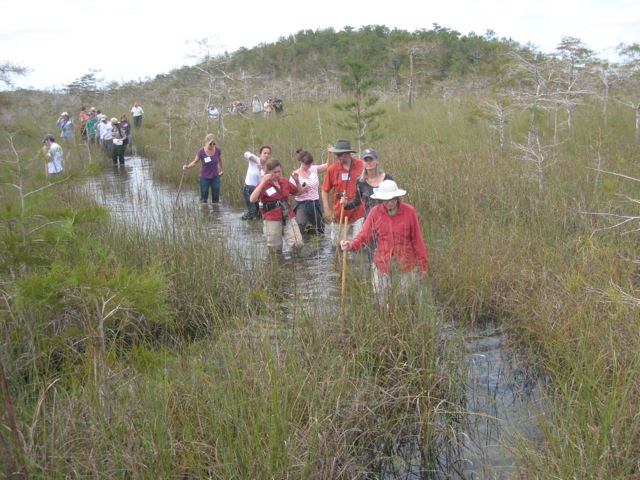Chris, hatless in red shirt, slogs with journalists through the Everglades

Low water flows—from Everglades National Park interpretor Alan Scott:
Water flow in the Everglades is only one-sixth what it used to be 100 years ago.
Development has halted water flow south of the gigantic Lake Okeechobee, which is supposed to feed the Everglades by seeping 100 miles south over three months. Today, highways, agriculture, and houses have resulted in a pipe system near the lake that shoots huge amounts of water out to the sea, instead of seeping south. Because so much water is dumped to the sea up north, by January the Everglades “river of grass” will dry up so much that it crunches beneath your feet.
Invasive snakes and other animals—from Everglades National Park biologist Skip Snow:
The Burmese python is the “poster snake” for the problem of released non-native species. People tired of their fast-growing pet pythons started dumping them in the Everglades many years ago. The first found in the national park showed up in the mid-1990s. Soon after, scientists realized they were breeding and migrating west, as far as the Florida Keys.
Found in the stomachs of dead pythons found in the Everglades: hooves of a fawn; the bill of a Great Blue heron.
Activists—from Jonathan Ullman, activist with the Sierra Club in Florida:
Two big activists who helped establish Everglades National Park both moved to Florida from other states. Marjory Stoneman Douglas, author of River of Grass, came from Massachusetts via Minnesota after her early divorce. Her father was publisher of the Miami Herald. Ernest Coe arrived in the subtropics at the age of 60 after many years designing landscapes in Connecticut. Both fell under the spell of the Everglades and devoted their lives to preserving it.
Water use—from Peter Gleick, climate and water scientist, Pacific Institute:
Per capita water use and total water use in the United States have been going down for 30 years.
That’s averaged over a nation. Some regions like the Southwest, near crisis as levels of stored Colorado River water drop.
Tremendous amounts of water go to cooling electric power plants and, more and more, to produce energy (as in fracturing rock (“fracking”) for natural gas).
Climate change is increasing droughts in some countries and leading to extreme precipitation in others. Parts of Central America suffered 60 inches of rain over a few days.
Energy subsidies and renewable energy—from Paul Bledsoe, Bipartisan Policy Center:
For most energy types, incentives [like rebates and tax breaks, the sort of carrots to help people buy solar panels] are not a major driver.
The U.S. Department of Energy says the United States could generate 20 percent of U.S. energy needs from wind without having to store the energy.
Increases in energy efficiency have had a huge impact in places like California, where power supplies sometimes waver.
Drilling in the Arctic—from several Arctic/conservation experts:
22 percent of undiscovered oil resources will be found in the Arctic in coming years.
Drilling for oil offshore in the U.S. Arctic will happen. The question is how it’s regulated.
